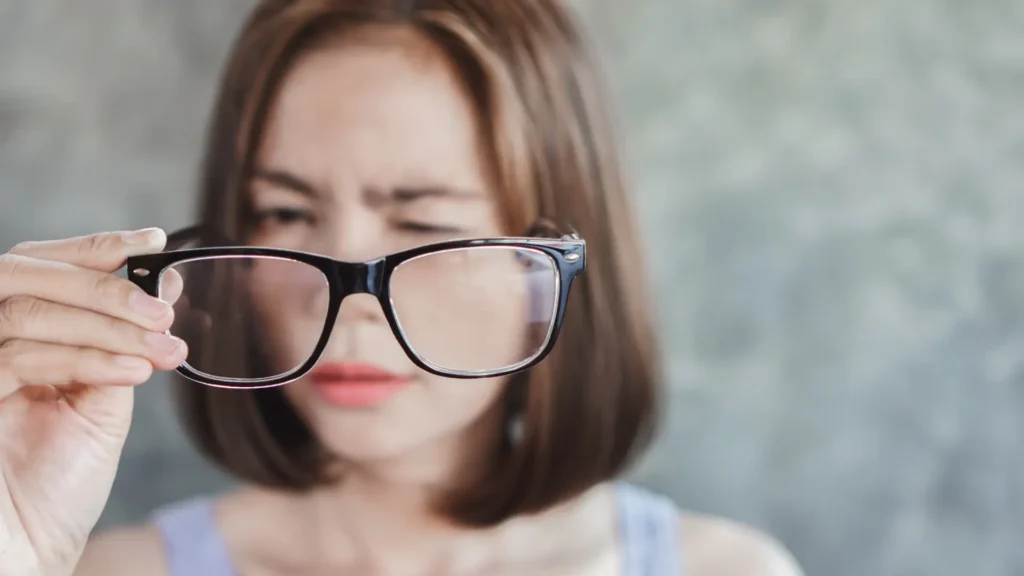In this article, we will be talking about common eyesight problems. These problems can affect people of all ages and can have a significant impact on daily life. It is important to be aware of these issues, their causes, and the available treatment options.
Refractive errors occur when the shape of your eye blocks light from focusing correctly on the retina, resulting in blurred vision. These are some of the most common eye problems, including:
- Myopia (nearsightedness)
- Hyperopia (farsightedness)
- Astigmatism
Today, we will explore these refractive errors and other common vision issues like presbyopia and age-related macular degeneration (AMD). Understanding these conditions is crucial for maintaining good eye health and finding the right treatment. Also, getting regular eye exams to detect these conditions early can make a significant difference in preserving your eyesight.
1. Myopia (Nearsightedness)
Myopia, commonly known as nearsightedness, is a refractive error where distant objects appear blurry while close ones remain clear. This a common eyesight problem that occurs when the eye’s length is too long or the corneal curvature is excessive, causing light to focus in front of the retina.
Symptoms of Myopia
- Blurred vision when looking at distant objects
- Squinting to see clearly
- Headaches due to eyestrain
- Difficulty seeing while driving, especially at night
Causes and Risk Factors
- Genetics: Higher risk if parents are myopic
- Environmental Factors: Limited outdoor activities and excessive near work
- Screen Time: Increased incidence in children linked to prolonged use of digital devices
Current Treatment Options for Myopia
- Prescription Eyeglasses and Contact Lenses: Corrective lenses compensate for the focusing errors.
- Atropine Eye Drops: Low-dose atropine drops have been shown to slow myopia progression in children.
- Orthokeratology (Ortho-K) Therapy: Overnight wear of specialized contact lenses reshapes the cornea temporarily.
Myopia Control Measures
Active myopia control strategies aim to reduce progression:
- Encouraging regular breaks from near tasks
- Prioritizing time spent outdoors
- Considering treatments like Ortho-K and low-dose atropine under professional guidance
When to See an Eye Doctor
Seek a comprehensive eye examination if you notice:
- Persistent blurred distance vision
- Frequent squinting or eye discomfort
- Changes in visual clarity affecting daily activities
2. Hyperopia (Farsightedness)
Hyperopia, also known as farsightedness, is a common eyesight problem where nearby objects appear blurry, while distant objects remain clear. This occurs when the eyeball is too short or the cornea is too flat, causing light to focus behind the retina instead of directly on it.
Key Aspects of Hyperopia:
- Unlike presbyopia which is an age-related condition, hyperopia can affect individuals of all ages and is often present from birth.
- Common symptoms include difficulty focusing on close-up tasks like reading or using a computer, squinting, eye strain, and headaches.
Diagnosis and Correction:
During an eye examination, hyperopia can sometimes be masked by a phenomenon called accommodation. This happens when the natural lens of the eye adjusts its shape to help bring nearby objects into focus.
To correct hyperopia and ensure clear vision, there are two main options:
- Eyeglasses or contact lenses: This is the most common and non-invasive method of correcting hyperopia. These optical devices help to bend light rays before they enter the eye, allowing for proper focusing on the retina.
- Refractive surgery: In certain cases, individuals may opt for surgical procedures such as LASIK (Laser-Assisted in Situ Keratomileusis) to permanently reshape the cornea. By altering its curvature, light entering the eye can be accurately focused onto the retina.
Understanding refractive errors like hyperopia not only enhances our knowledge of vision conditions but also helps recognize symptoms early for appropriate intervention. Now let’s dive into another prevalent refractive error – astigmatism.
3. Astigmatism
Astigmatism occurs when the cornea or lens has an irregular shape, causing light entering the eye to bend unevenly. This results in distorted vision and can make objects appear blurry or stretched out, regardless of their distance.
Signs and Symptoms:
Some common signs and symptoms of astigmatism include:
- Blurred or distorted vision
- Difficulty seeing clearly at night
- Eye strain or discomfort
- Headaches caused by squinting or eye strain
Diagnosing Astigmatism:
If you suspect you have astigmatism, it’s important to schedule a comprehensive eye exam with an optometrist or ophthalmologist. During this exam, various tests will be conducted to determine the nature and severity of your astigmatism. These tests may include:
- Visual acuity test: You’ll be asked to read letters on a chart from a specific distance.
- Keratometry: This test measures the curvature of your cornea using a special instrument called a keratometer.
- Corneal topography: It creates a detailed map of your cornea’s surface, helping identify any irregularities.
By performing these tests, your eye care professional can accurately diagnose astigmatism and recommend suitable treatment options.
Treating Astigmatism:
While astigmatism cannot be prevented, various treatment options are available to help correct your vision and manage its symptoms:
- Corrective lenses: Eyeglasses or contact lenses with a special prescription can compensate for the irregular shape of your cornea, allowing light to focus properly on your retina.
- Orthokeratology (Ortho-K): This non-surgical procedure involves wearing specially designed rigid contact lenses overnight to temporarily reshape your cornea. Throughout the day, you can enjoy clear vision without the need for glasses or contacts.
- Laser surgery: For those seeking a more permanent solution, laser eye surgeries such as LASIK may be recommended. During these procedures, a laser is used to reshape the cornea, correcting its imperfections and improving your vision.
It’s important to discuss these options with your eye care professional to determine which treatment approach is best suited for your specific needs and lifestyle.
4. Presbyopia and Age-Related Vision Changes
As we get older, our eyes naturally go through some changes, one of which is presbyopia. This condition affects your ability to focus closely on objects, making activities like reading a book or texting on a smartphone increasingly challenging.
What Causes Presbyopia
The root cause of presbyopia is the natural aging process in which the eye’s lens hardens over time. This reduced flexibility impairs the eye’s ability to shift focus from far to near objects effectively.
Symptoms of Presbyopia
Struggling to read small print, especially in dim light, or experiencing headaches or tired eyes after close-up work are common telltale signs.
Treatment Options for Presbyopia
Once diagnosed with presbyopia, it’s crucial to understand the available treatment options and necessary lifestyle adjustments:
- Reading glasses: A common solution that can be customized to your presbyopic prescription.
- Progressive lenses and multifocal contacts: These can correct distance vision and near vision simultaneously.
- Surgical options: Monovision LASIK is one such procedure where one eye is corrected for near vision and the other for distance vision.
Remember, regular eye exams are key to timely detection and treatment of presbyopia.
5. Age-Related Macular Degeneration (AMD)
Age-related macular degeneration (AMD) is a common eyesight problem that primarily affects individuals aged 50 and above. There are two forms of AMD:
- Dry AMD: This is the most common form of AMD and is characterized by the thinning of the macula.
- Wet AMD: Although less common, wet AMD is more severe and involves the growth of abnormal blood vessels beneath the retina.
Several key factors contribute to the development of AMD, including age, smoking, and genetics. The symptoms of AMD usually begin with blurred or reduced central vision and may progress to blind spots in your visual field or a complete loss of central vision.
While AMD does not typically cause total blindness, it can greatly impact your ability to perform tasks that require clear central vision such as reading or driving. Therefore, it is crucial to undergo regular eye screenings for early detection and management of this condition.
6. Cataracts
Cataracts are a common eyesight problem where the eye’s natural lens becomes cloudy, causing blurry or hazy vision. It is primarily caused by aging, but factors such as diabetes, smoking, excessive sunlight exposure, and certain medications can also play a role.
Some common symptoms of cataracts include:
- Blurry or hazy vision
- Difficulty seeing at night
- Increased sensitivity to light and glare
- Seeing “halos” around lights
- Frequent changes in eyeglass prescriptions
If left untreated, cataracts can lead to significant vision loss. However, the good news is that they are treatable. The most common treatment for cataracts is surgery, where the cloudy lens is replaced with an artificial one. This procedure has a high success rate and can greatly improve vision quality.
7. Diabetic Retinopathy
Diabetic retinopathy is an eye condition that occurs as a complication of diabetes. High blood sugar levels can damage the small blood vessels in the retina, disrupting its ability to sense light and resulting in vision loss.
Diabetic retinopathy progresses in stages:
- Non-proliferative diabetic retinopathy (NPDR): The earliest stage, marked by swelling and leakage in the retina’s blood vessels.
- Proliferative diabetic retinopathy (PDR): A more advanced stage, characterized by the growth of abnormal new blood vessels on the surface of the retina.
It’s essential to diagnose and manage diabetic retinopathy early, as it may not produce noticeable symptoms until significant eye damage has occurred. Periodic eye examinations are crucial for those with diabetes.
Treatment varies based on the severity of the disease. It can involve:
- Laser treatment, to seal off leaking blood vessels and inhibit the growth of new ones.
- Injections into the eye, delivering medication that slows down disease progression.
- Surgery, especially if there is a significant hemorrhage or retinal detachment.
8. Glaucoma
Glaucoma is an eye condition where the optic nerve gets damaged, mostly because of high pressure inside the eye. There are two main types of glaucoma:
- Open-angle glaucoma: This type progresses slowly and often has no early signs, so it’s important to have regular eye check-ups.
- Angle-closure glaucoma: This type develops suddenly and needs immediate medical attention due to its fast progression.
Some factors that increase the risk of developing glaucoma are age, ethnicity, family history, and certain health problems like diabetes or high blood pressure. The common symptoms include:
- Gradual loss of side vision
- Severe eye pain, nausea, and vision problems in severe cases
The treatment options for glaucoma include:
- Using medicated eye drops to reduce the pressure inside the eye
- Surgery for more advanced cases to improve fluid drainage and lower the pressure on the optic nerve
Read More: Understanding Abnormal Blood Tests: What You Need to Know
Conclusion

It’s crucial to understand the significance of being aware and taking immediate action against common eyesight problems, refractive errors, age-related vision changes, and different eye conditions. Getting timely treatment can greatly help in effectively managing these problems.
Making eye health a top priority is essential for personal healthcare. So take the necessary step to protect your vision—book a comprehensive examination with an optometrist or ophthalmologist today.


